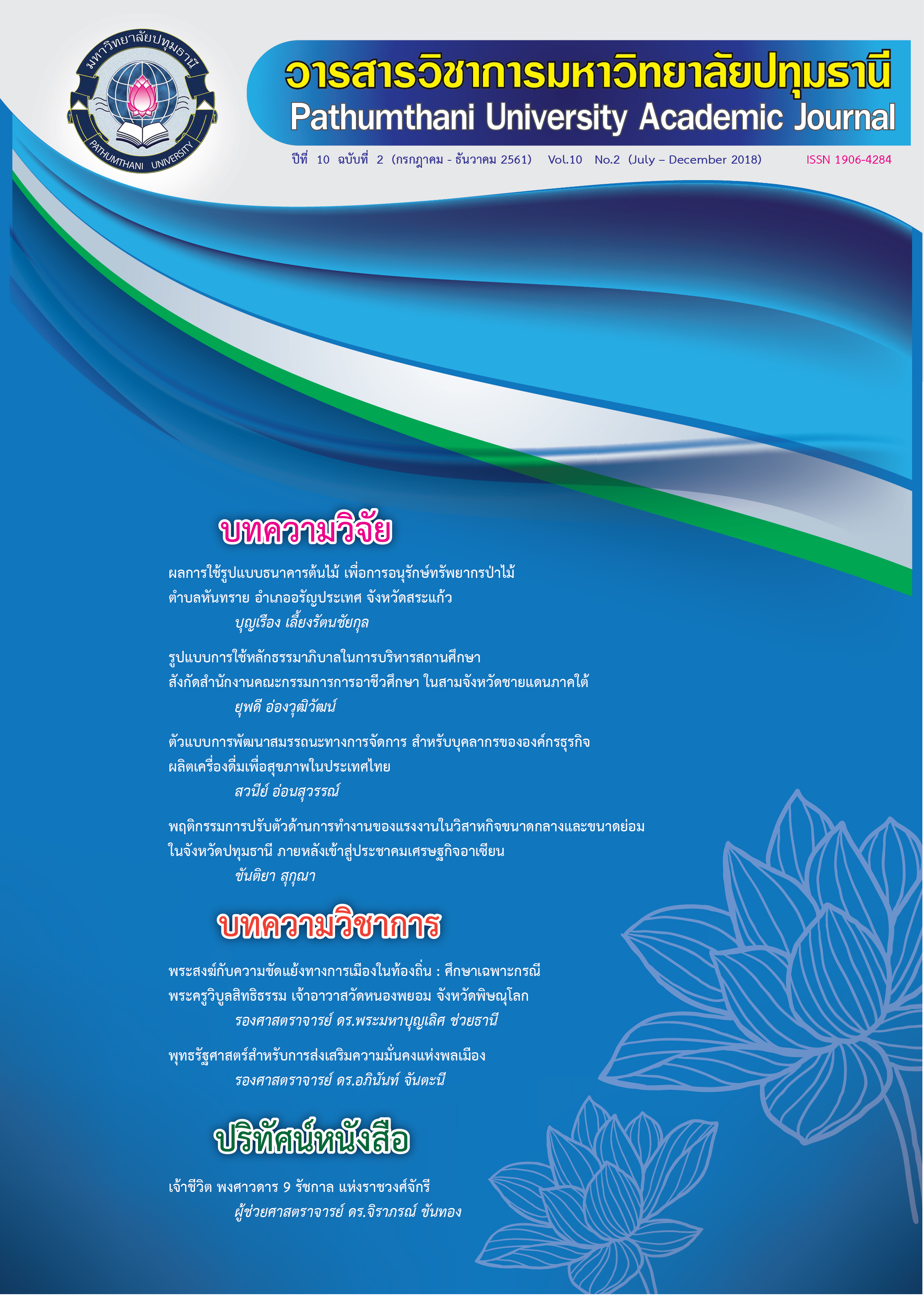แนวทางความสำเร็จในการดำเนินธุรกิจอุตสาหกรรมสีเขียว ของโรงงานอุตสาหกรรม จังหวัดปทุมธานี
Keywords:
แนวทางความสำเร็จในการดำเนินธุรกจอุตสาหกรรมสีเขียวโรงงานอุตสาหกรรมAbstract
This research were qualitative and quantitative method aim to evaluate the significant level of business operating of green industry manufacturing and business operating successful factors of manufacturing in Pathumthani Province, compare business operating successful factors of manufacturing and found relative between business operating of green industry manufacturing and business operating successful factors and successful business operating approach of Green industry manufacturing Pathumthani Province. By simple random sampling 355 respondents. Questionnaire was the tool to collecting data with validity at level .83 and Reliability at level .86. The analysis was conducted by computer software, statistical treatments by program computer namely: frequency, percentage, mean, standard deviation, ranking, Pearson correlation, and Step white multiple regression analysis at significant statistics level at .05 searches found that. 1. The majority of respondents were manager 115 respondents (32.4%), their employees between 201 –300employees 106 respondents (29.9%),first investment more than 301 million Baht 151 respondents (42.5%),and working experience between 1–10years 176 respondents (49.6%). 2. Finding indicated that overall and every area of business operating of green industry manufacturing were high significance level, However, the raking of business operating of green industry manufacturing by mean in term the first were proper disposal of waste ( = 3.94) management for green production ( =3.87) Pollution Prevention ( =3.85) use less reuse use revolving ( =3.77) energy efficiency optimization by international standard ( =3.70) environment surveillance network ( =3.53) production of replacement products ( =3.52) future pollution prevention ( =3.44) and water conservation ( =3.43) respectively. 3. Finding indicated that over all area of factors leading to business success of manufacturing were at high level, raking by mean first creative and innovation area ( =4.16), manufacturing management quality ( =4.09) social responsibility ( =4.05), manufacturing financial system ( =4.04), manufacturing clever use of property ( =3.90), global business capability ( =3.78), ability to recruits and retain talented people ( =3.76), risk management ( =3.75), and products area ( =3.55) at the high level respectively. 4. Hypothesis tested finding indicated that 4.1 There were not significant different of factors leading to business success of Manufacturing level in term of working experience , number of employees, but there were significant different in term of position, and first investment at statistic significant level .05 4.2 There was high relationship positive direction between overall area of business operating of green industry manufacturing and factors leading to business success of manufacturing in Pathumthani province. 5. Successful Business Operating Approach of Green Industry Manufacturing Pathumthani Province = 116.45 +.987 products +.981 creative and innovation +.896 social responsibility +.778 global business capability +.767 manufacturing financial system +.701 manufacturing clever use of property +.662 risk management area.
References
2. ปัญจ์ปพชัรภร บุญพร้อม. (2557). “เครื่องมือสำหรับการจัดการสิ่งแวดล้อมอย่างยั่งยืน”. วารสารสุทธปิริทัศน์. ฉบับ 2. มิถุนายน.
3. ณัฐพล บัวเปลี่ยนสี. (2557). ปัจจัยที่มีผลต่อความสำเร็จในการบริหารจัดการของผปู้ระกอบการอุตสาหกรรมยานยนต์ในเขตนิคมอุตสาหกรรมภาคตะวันออก. วิทยานิพนธป์รญิญาบริหารธุรกิจมหาบัณฑิต สำหรับผู้บริหาร. มหาวิทยาลัยบูรพา.
4. สำนักงานอุตสาหกรรมจังหวัดปทุมธานี, กระทรวงอุตสาหกรรม. (2556). [ออนไลน์]. ข้อมูลและสภาวะ อุตสาหกรรม จังหวัดปทุมธาน ีปี 2555. สืบค้นเมื่อวันที่ 12 กรกฎาคม 2556. เข้าถึงได้จาก : http://www.industry.go.th/ops/pio/pathumthani/Lists/annuity/
5. อรวรรณ สุทธิพิทักษ์. (2546). ศึกษากลยุทธ์สู่ความส าเร็จของวิสาหกิจชุมชน : ศึกษาธุรกิจกะลาตำบลชัยบุรี อำเภอเมือง จังหวัดพัทลุง. วิทยานิพนธ์ปริญญาบริหารธุรกิจมหาบัณฑิต สาขาการบริหารธุรกิจ. มหาวิทยาลยัธุรกิจบัณฑิตย์.
6. อัจฉรา จันทร์ฉาย และ อรรณพ ตันละมัย. (2556). การจัดการสิ่งแวดล้อมของอุตสาหกรรมอาหารแปรรูป. จุฬาลงกรณ์มหาวิทยาลัย.
7. Hay Group. (2012). FORTUNE World’s most admired companies: Frequently asked questions. [Online]. Retrieved August 18, 2013. from http://www.haygroup.com/Fortune/results/ faqs.aspx
8. Kim, W.C. and Mauborgne. (2005). Blue Ocean Strategy. Upper Saddle River, New Jersey : Pearson Education, Pearson Prentice Hall.
Downloads
Published
How to Cite
Issue
Section
License
บทความที่ได้รับการตีพิมพ์เป็นลิขสิทธิ์ของวารสารมหาวิทยาลัยปทุมธานี
ข้อความที่ปรากฎในบทความแต่ละเรื่อง เป็นความคิดเห็นส่วนตัวของผู้เขียน กองบรรณาธิการไม่จำเป็นต้องเห็นด้วยเสมอไป และไม่มีส่วนรับผิดชอบใด ๆ ถือเป็นความรับผิดชอบของผู้เขียนแต่เพียงผู้เดียว



